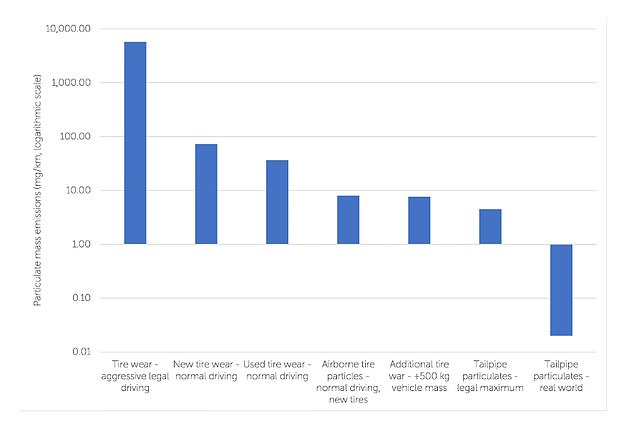Electric cars emit more toxins than gasoline-powered vehicles and are worse for the environment
According to a recently surfaced report, electric vehicles can cause more pollution than gasoline-powered vehicles.
The study, which was published in 2022 but has returned to circulation after being quoted in a WSJ op-edResearch has shown that brakes and tires release 1,850 times more particles than modern exhaust pipes fitted with filters that reduce emissions.
It found that electric vehicles are on average 30 percent heavier than gasoline-powered vehicles, causing brakes and tire treads to wear out faster than standard cars and releasing small, often toxic particles into the atmosphere.
Hesham Rakha, a professor at Virginia Tech, told Dailymail.com that the research is only “partially correct” because even though electric cars are heavier, their tires will emit more microplastics into the air, but this could also apply to sedans versus SUVs.
According to a recently surfaced report, electric vehicles can cause more pollution than gasoline-powered vehicles
Rakha said determining the difference between the amount of microplastics emitted from the tread of EV tires and from gasoline vehicles is challenging because you have to separate the microplastics already in the air from other sources with what’s comes out of the tires.
Rakha and his team at Virginia Tech are conducting field tests to determine how much microplastics are emitted by electric and gasoline cars using traffic simulators that mimic an urban environment.
He added that he doesn’t expect there to be a big difference between electric vehicles and gasoline-powered vehicles. He says they haven’t measured it yet, but expect the difference to be about 20 percent.
This doesn’t mean people should turn away from electric cars because they are “more efficient depending on zero emissions,” Rakha said, but he added that “it also generates a lot of CO2 when charging your vehicle.”
EV batteries weigh approximately 453 kg and can result in tire emissions nearly 400 times higher than exhaust emissions.
Particulate pollution can increase health problems, including heart disease, asthma and lung disease, and in extreme cases can lead to hospital admissions, cancer and premature death.
New petrol cars are made to be ‘cleaner’, by updating the coverings of their combustion engines with particulate filters that reduce emissions.
The electric vehicles have become heavier thanks to their lithium-ion batteries, which causes the tire tread to wear out faster, ultimately causing more emissions.
The study, conducted by the Emissions Analytics firm, said the main difference between tailpipe and tire emissions is that the majority of particulate emissions released from the tire go directly into soil and water, while exhaust gases negatively affect air quality.
The effects of tire composition come down to the materials the tire is made of, the study reports.
Light duty tires are typically made of synthetic rubber developed using crude oil, natural rubber, with fillers and additives added, some of which are recognized carcinogens.
Emissions Analytics tested tire wear on both electric and gasoline vehicles after driving at least 1,000 miles.
The researchers used a sampling system to collect particles directly behind each tire and then measured the size of the particles emitted by the tread.
It turned out that the greater the mass and weight of the vehicle, the faster the emissions of soot particles are released due to the greater torque between the tires and the road.

New research shows tire wear produces more CO2 emissions than an exhaust pipe, despite claims that electric vehicles produce no emissions
A special one Report 2020 of the company Emissions Analytics said tires are likely to be a major problem in the coming years as “consumers move to larger and heavier cars.”
“Research shows that they contribute to marine pollution by microplastics, but also to air pollution by finer particles,” the report continues.
